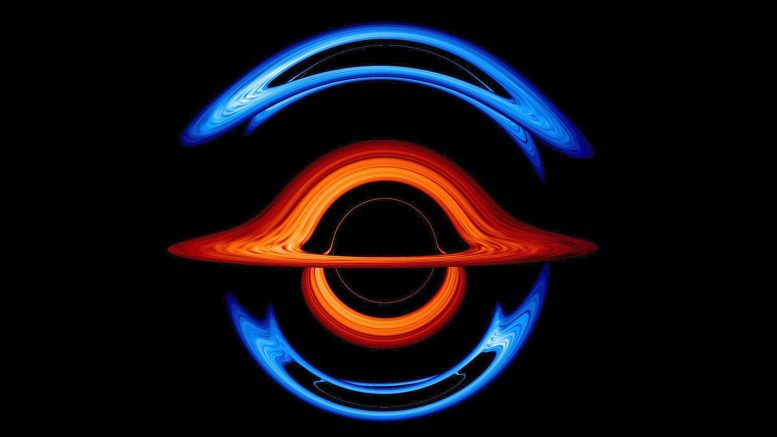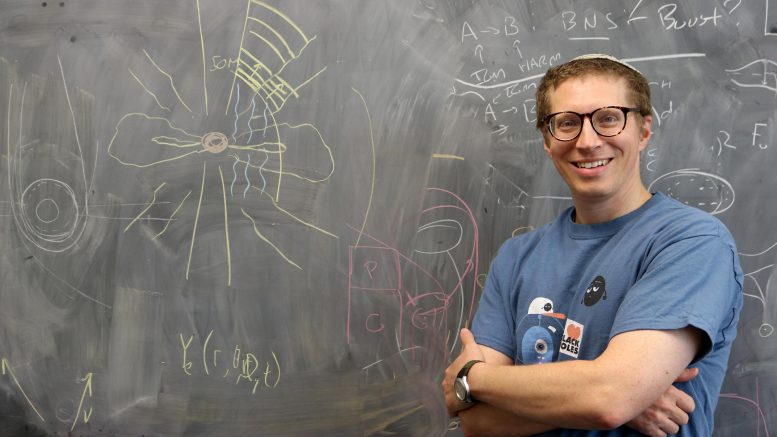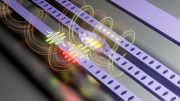
In this frame from a new visualization, a supermassive black hole weighing 200 million solar masses lies in the foreground. Its gravity distorts light from the accretion disk of a smaller companion black hole almost directly behind it, creating this surreal view. Different colors for the accretion disks make it easier to track the contributions of each one. Credit: NASA’s Goddard Space Flight Center/Jeremy Schnittman and Brian P. Powell
What is a black hole? How do we study them when we can’t see them? Astrophysicist Jeremy Schnittman from NASA’s Goddard Space Flight Center joins NASA Chief Scientist Jim Green for a fascinating conversation about the latest black hole research.
Jim Green: NASA’s celebrating black hole week. Let’s talk to an expert who can tell us about these very strange and mysterious objects.
Jim Green: Hi, I’m Jim Green. And this is a new season of Gravity Assist. We’re going to explore the inside workings of NASA in making these fabulous missions happen.
Jim Green: I’m here with Dr. Jeremy Schnittman. And he is a research astrophysicist at NASA’s Goddard Space Flight Center. He joins us here on Black Hole Week, when NASA is celebrating that very strange and mysterious object we call black holes. Welcome, Jeremy, to Gravity Assist.
Jeremy Schnittman: Thanks, Jim. It’s great to be here.
Jim Green: Your NASA webpage states that you call yourself a “general purpose astrophysicist theorist.” What does that mean? And what do you do?
Jeremy Schnittman: Well, I think maybe it’ll help to, to describe to the audience first what is an astrophysicist in the first place? Right? Almost sounds like a made-up job. Sometimes I think it is. It’s such a great job. Not to compare myself, but I think really the first astrophysicist that we know of it was Isaac Newton. Right? He was an astrophysicist because he took the laws of physics that he could see on Earth, right, the famous one about the apple falling, he could measure gravity on Earth. And he applied it to the heavens, he applied it to astronomy. So that’s how you get “astrophysicist.” You’re taking what we know about physics from a laboratory or from theories that we develop here on Earth, and applying it to the entire universe. And so that’s, that’s what I do.
Jeremy Schnittman: Why do I call myself a “general purpose astrophysicist” — I guess it’s because I’m not really expert in anything, but you know, try to dabble a little bit in everything. When it comes to black holes, they really are a great intersection of everything.
Jim Green: You’re right, black holes requires all kinds of knowledge. So, what got you really interested in the topic of black holes?
Jeremy Schnittman: I guess it started with, you know, right the beginning of graduate school. I mean, everybody, we grew up learning about black holes a little bit in school, and everybody knows that they’re really cool and mysterious objects. But when I got to graduate school, I started learning about, you know, what, what a black hole really is. What does it really mean to be a black hole? What does it really mean to study black holes?
Explore how the extreme gravity of two orbiting supermassive black holes distorts our view. In this visualization, disks of bright, hot, churning gas encircle both black holes, shown in red and blue to better track the light source. The red disk orbits the larger black hole, which weighs 200 million times the mass of our Sun, while its smaller blue companion weighs half as much. Zooming into each black hole reveals multiple, increasingly warped images of its partner. Watch to learn more. Credit: NASA’s Goddard Space Flight Center/Jeremy Schnittman and Brian P. Powell
Jim Green: What exactly is a black hole?
Jeremy Schnittman: Even amongst the experts, I think you could probably find a disagreement about whether a black hole is an object, or is it just a part of space? It, it obviously starts off as an object, it starts off, most of them, we believe start off as massive stars that burn up all of their fuel during their lifetime. When you have a star that’s much bigger than the sun, it it burns this fuel much hotter, and much faster. And after just a few million years, as opposed to the sun, which is billions of years old. After just a few million years, you’re done with your fuel.
Jeremy Schnittman: So there’s no more heat holding the Sun up, and the gravity, there’s still all the gravity, you just don’t have that hot gas and, and pressure holding the star up, the gravity is going to win. And it collapses into, into what we call a singularity. Which is like just an explosion of density, of energy, of mass, we’re not really quite sure. I personally just think of it as a, as a hole in space right? They’re a nice round hole described by a lot of mathematical equations.
Jeremy Schnittman:You have this famous edge of the black hole we call the event horizon. And that’s really where nothing, nothing can escape from not light, not particles. Nothing at all.
Jim Green: So if we can’t see them, because the light is not allowed to leave this particular area, how do we really study them?
Jeremy Schnittman: There’s this kind of irony of black holes that are black and invisible. But they’re also some of the brightest objects in the entire known universe. And the reason is, because when you tend to get too close to a black hole, if you’re a planet or a star cloud of gas, you get whipped around into a really fast orbit going nearly the speed of light, heated up to millions of degrees and shining out in bright ultraviolet, X-ray, radio, just really bright, bright sources of light coming from not the black hole itself, but from the effect that it has on anyone who gets too close to it. So that’s why, that’s how we see them. That’s how we study them. For the most part.
Jeremy: There are a couple other ways that you can study them, not through the material immediately around the black hole. Anything that is affected by gravity, we’ll be able to, to measure it and use it kind of indirectly to infer the properties of the black hole. So if you see a star in the middle of space, just moving around in a circle around nothing, that’s a pretty good hint that there’s something like a black hole right next to it.
Jim Green: Well, how close can you get to a black hole before you fall in?
Jeremy Schnittman: I guess this depends on your rocket ship. If you’re just, you know, a run of the mill astronaut floating through space, you really want to keep your distance. You don’t want to get anywhere within, you know, the strong, strong gravitational pull of a black hole, maybe 10s or 20s of times the black hole’s radius.
Jeremy Schnittman: If you have a really good rocket where you can fire your retro rockets and you know, kind of get down close and then pull away again, you can get up to about twice the black hole’s radius, what we call the Schwartzschild radius. And still escape if your rocket is, you know, can get you almost up to the speed of light. If you basically turn yourself into a photon going the speed of light, then you can get just up to the event horizon. But you better turn yourself perfectly around and head straight out again, before it’s too late. Once you get past that, and there’s no return.
Jim Green: Well, as you mentioned, some of the stars and produce supernova explosions are massive enough to become black holes. So we do see supernovae. We see them in other galaxies and even our own galaxy. So how far away is our closest black hole?
Jeremy: So of the of the black holes that, we’ve seen and observed in our own galaxy in the Milky Way. It’s really not that many.
Jeremy Schnittman: But one in 1,000 stars becomes a black hole at the end of its life. And if you think about the fact that we have over 100 billion stars in the Milky Way, you do the math and you end up with over 100 million black holes floating around the Milky Way. And we’ve seen 40 of them. So that leaves 99,999,000 and change that we’ve never even detected, and they’re just going to be sprinkled throughout the, the Milky Way, just like all the stars. And again, you do a little bit of math, and the chances are, that there’s a black hole that we’ve never even seen within only, say, 25 light-years of the Earth. I mean, it doesn’t pose any immediate risk. But I tell you, when whenever it happened, you know, billion years ago, when it went supernova, it would have been a pretty bright day out.
Jim Green: Yeah, no kidding.
Jeremy Schnittman: But if you had to bet, and you look up into the sky and you see a galaxy, I’d put pretty good money, that there’s a black hole in it.
Jim Green: Okay, so, are there tiny black holes? How small can a black hole be?
Jeremy Schnittman: Ah, that’s a good question. Since the only ones we really understand at all are these ones that come from collapsed stars. So those are kind of the smallest we’ve seen so far. But there’s no real reason you can’t form a smaller black hole. There’s a famous effect, predicted by Stephen Hawking, about, well, appropriately enough, called Hawking radiation, where a black hole actually leaks out a little bit of radiation from the surface, due to complicated quantum mechanical effects that I can’t claim to understand.
Jeremy Schnittman: But we, we know that we’ve never actually seen this in the lab or in space, but we know that if it exists, the smaller the black hole, the brighter the radiation, interestingly enough, so if you get too small, the black hole actually gives off a lot of radiation and then actually just evaporates and disappears in a in a big bang and flash of gamma rays.
Jeremy Schnittman: So, if you if you think about what, how small can you be it kind of is a question of how small can you be and still survive the Hawking radiation? It would be much, much smaller than the size of the Earth. And we haven’t yet seen anything like that. But again, no reason they might not exist.
Jim Green: So do more massive galaxies have more massive black holes do you think?
Jeremy Schnittman: They do. There seems to be a pretty tight relationship as you get to be a bigger and bigger galaxy, or more specifically, a bigger and bigger bulge, right? Just that that center region of stars, they get bigger and bigger. I mean, we think of 4 million times the size of the Sun is mind bogglingly huge. But by galaxy standards, it’s a, you know, it’s a drop in the bucket. We’ve seen black holes that are a billion times the size of the Sun, or even larger.
Jeremy Schnittman: And, but, but kind of interestingly, as you get to the really big galaxies with the really big black hole holes, the, the actual density of stars in that center region seems to go down a little bit. It’s what we call a core, it’s almost like a blender has scoured out those middle regions of the galaxy. And, and that’s kind of what we think happened is that the two galaxies merge, and they each had a black hole, the black holes fall in towards the center of the galaxy, they start whipping around each other, and just blend, you know, “Mix Master” throwing stars out left and right, and kind of clear out a little bubble in the center. And, and that’s what we’re seeing in some of these big galaxies.
Jim Green: Well, sometimes those two will merge. So what happens when we have two black holes merge?
Jeremy: So that is, that is the biggest brightest thing that ever happened in the universe, the merger of two black holes when they actually come together, give off something called gravitational waves. And those gravitational waves have energy just like electromagnetic waves, or ocean waves, or sound waves. The amount of energy that those things give off, actually, outshines the entire known universe, entire universe just from one pair of black holes for that, you know, five seconds, or even five hours depending on the size, how long it taking them to merge.
Jeremy Schnittman: Now, we can’t see this because our eyes don’t see gravitational waves. So it doesn’t, it’s not like a supernova where, you know, big bright blast in the sky. It’s more like a, a sound, a bang, than a flash in the sky. So only very, very recently, were we able to make the ears on Earth that could hear the sound of the of the gravitational waves, these ripples in the very fabric of reality that go propagating throughout the entire universe.
Jim Green: Jeremy, what is LIGO? And how did it make those spectacular measurements of gravitational waves?
Jeremy Schnittman: LIGO, the Laser Interferometer Gravitational Wave Observatory, is actually two different observatories in the United States. One is located in Louisiana, and one is in Washington State. And it’s been a big, massive project funded by the NSF. And there’s another sister observatory called Virgo In Europe, that’s also really leading the revolution in gravitational wave science.
Jeremy Schnittman: Gravitational waves are ripples in the fabric of space time. And one of the important things is, is it easy to picture ripples in space, right, like a piece of fabric stretching and shrinking. But it’s also important to think of it as the ripples in time, right? So it actually changes the amount of time it takes for a laser beam or a particle of light to go a certain distance. So the way that LIGO measures this, it’s very, really, really clever. It sends a race between two rays of light, and it kind of splits them with the mirror, and it sends one, one way in one the other way, and bounces off another mirror, which is actually miles away down a long tube, bounces the light back to the starting line and sees which, which light got there first. And from that you can tell, which, you know, kind of which leg of the race was a tiny bit shorter or a tiny bit longer due to this gravitational wave.
Jeremy Schnittman: And, you know, it sounds very simple and straightforward, but at the end of the day, we’re talking about light that’s going over 4 kilometers, and then 4 kilometers back in the one, and one ray of light is beating the other one by a fraction of the radius of a proton.
Jim Green: Wow!
Jeremy Schnittman: So it is no small task from a technological point of view to run this race, but they did it and we’ve been reaping the benefits ever since.
Jim Green: How excited were you? And what were you thinking about when you, when you heard about these results?
Jeremy Schnittman: I mean, it was it was really cool. I, I sometimes think of it as you know, when you have your when you have your first child, right? It’s very exciting. But you know, it’s not a huge surprise. I mean, you had nine months to somewhat prepare for it, you know, it’s coming but still when it, when it finally happens, even though you’ve been working on it for years, in cases, it’s still just a magical experience and it’s, you know, as a physicist working in in black holes and gravitational waves, it is also kind of, you know, like telling us, “Oh, you guys, you were right all along.” And you know, who doesn’t like to hear that?
Jim Green: Well, you know, it really opens up a new horizon for us in terms of developing new telescopes or techniques to measure these gravitational waves. What are the particularly new telescopes or upcoming observations that you’re excited about?
Jeremy Schnittman: Yes, so especially for the gravitational waves. When two black holes collide, they make gravitational waves. But like a bell or a, or tuning fork, right, different size, black holes make different types of waves, you can get a really, kind of, short, high-pitched sound or a very long, deep ripple going through, through space. So, like we’ve been talking about, we have these two different types of black holes, the ones about the size of the Sun, or a few times the size of the Sun. And those are the ones that we’ve detected the gravitational waves from with LIGO, which are these giant lasers on the surface of the Earth.
Jeremy Schnittman: To get the supermassive black holes, the gravitational waves from those, they’re going to be at a much lower frequency. So to hear those, we actually need to build a detector in space. And that’s one of the big projects that we here at NASA are working on, called LISA, the Laser Interferometer Space Antenna. And it’s interesting, that it’s called an “antenna,” as opposed to an “observatory,” right. “Observatory,” you think of kind of like a telescope, you pointed out a star and you take a picture. An antenna, it’s just going to be listening all the time to everything in space. And that’s what we’re going to use to hear these deep rumble waves from merging supermassive black holes throughout the universe.
Jim Green: So LISA is a fantastic European Space Agency project that NASA and several other agencies are really excited about. And it requires at least three spacecraft that look at each other with lasers. Do you think that’s gonna really solve a lot of the next problems that we want to know about black holes?
Jeremy Schnittman: For sure, one of the biggest ones that we want to answer is, like we were saying before, where do these supermassive ones come from? I mean, it would, it would be like if, if living on Earth, you know, we knew of, you know, insects and dinosaurs, and nothing else. Like, how is that even possible. But if you look at the fossil record, you can kind of piece them all together, all the missing links in between. And we hope that LISA will help us kind of dig through the fossil record in real time. Because, you know, one of the great things about astronomy is you look at things far away, you see what they were looking like a long time ago. So by looking at the entire universe, which LISA will be able to do, you can see the evolution from really just a short time after the Big Bang all the way up to now.
Jim Green: So, you’ve been working on this, I don’t know, at least a decade, maybe more, what’s some of the most exciting results that have come out recently?
Jeremy Schnittman: So I think hands down the, the biggest recent discovery with, with black holes, I guess, since the LIGO era hit in 2015, was this very famous release of the Event Horizon Telescope image where they took an actual picture of a black hole, released just about two years ago in in April 2019, using this huge network of radio interferometers. And these are different interferometers than LIGO. But they’re used to actually take a picture of a black hole so that they could zoom into this tiny, tiny, tiny space millions of light-years away, and actually see what the what the black hole looks like. Again, it’s not, not the actual black hole, we’re picturing the gas immediately around the black hole. But for all intents and purposes, that’s the same thing. And we’re really excited about seeing where, where we can go next with this type of technology.
Jim Green: Out of all the unknowns about black holes? What’s the one question that you, Jeremy, would like to be the one to answer?
Jeremy Schnittman: It’s kind of obscure. But one of the things that I, I actually made a prediction of in graduate school is that when you have two of these black holes orbiting around each other, and getting closer and closer and merging into a single black hole through gravitational waves, the spins of the black hole, kind of the way that they’re oriented, should be aligned in a very specific way. So we haven’t yet got enough data to prove that one way or another. But hopefully within the next few years with something like LIGO, we’ll be able to identify this effect and maybe even proven an old prediction right. So that would be exciting. For me, personally, I don’t know if anybody else would care.
Jim Green: Oh, I think that’s fantastic. I would. I’ll be on the lookout for that. That’s wonderful.
Jim Green: Well, you know, Jeremy, I always like to ask my guests to tell me what was that event or person place or thing that got them so excited about becoming the scientists they are today? Now it’s very appropriate today in particular that I call that event a gravity assist. So Jeremy, what was your gravity assist?
Jeremy Schnittman: Yeah, I was, I was thinking about that, too, Jim, is you know, as gravity assist is the perfect name for our discussion today, because black holes are all about gravity. That being said, my, you know, my real foray into physics and real physics research, had nothing to do with gravity. It was when I was a junior in high school, I got to do a summer research program very fortunate and privileged to have been able to participate in that the University of Rochester and they have a giant laser lab where they use mega, megawatt mega-megawatt lasers to do nuclear fusion experiments.
Jeremy Schnittman: And I, you know, got to see firsthand what, what real physics research was, was like. It wasn’t like homework. It was finding answers to problems that nobody had ever solved before. And it was just captivating and you know, never looked back. From then on, I just knew exactly that’s this is what I wanted to do.
Jim Green: Yeah, that’s fantastic. Well, Jeremy, thanks so much for joining me in this fascinating discussion about black holes.
Jeremy Schnittman: Oh, it was a pleasure. I always love talking about space and I love talking about black holes. Thank you.
Jim Green: Well, join me next time as we continue our journey to look under the hood at NASA and see how we do what we do. I’m Jim Green and this is your Gravity Assist.










Nice one eyed symbolism in that stupid CGI photo… The dumbed downasses dont get it. The eye of illumination.
Animacija pomračine [ekliptike] Binarnih BH ima uvijete odnosa masa [1:1,9] dvostukosti, a potpunost, se može [mora] triangulirati, pa se dobiju 2. moguće vrednosti zatamnjena u [100% ekliptike] a ispravna pomrčina je samo kada manja BH nama prođe ispred 1,9 X veće! Zatamnjenje potiče od točne međusobne udaljenosti 1M BH,i veće 1,9 M BH i faktora crnog pixela [diferencije zračenja crnog tijela]! Kada potvdimo ispravnost, mi taj podatak ne ćemo bitno korisno iskoristiti osim za provjeru točnih odnosa masa, koje smo drugim metodama mjerili, ili pretpostavili? Velika je šteta što ipak vidimo boju crnog tijela, koju tidal [plimnim] privlačnosti bez bijega fotona,niti možemo mjeriti? Dakle stvarne SMBH su možda i dvostruko precijenjene, pa sadrže Jezgru i šuplje tijelo, iz kojeg pušu vjetrovi proizvodeći gama zrake Diska Akrecije, ili izbace materijal Zvijezde [nakon 3 god.] kojoj se mi ne potrudimo vidjeti Vodik ili Helij spektra, a niti polarizaciju koja bi otkrila snagu magneta BH, ili Akrecije?